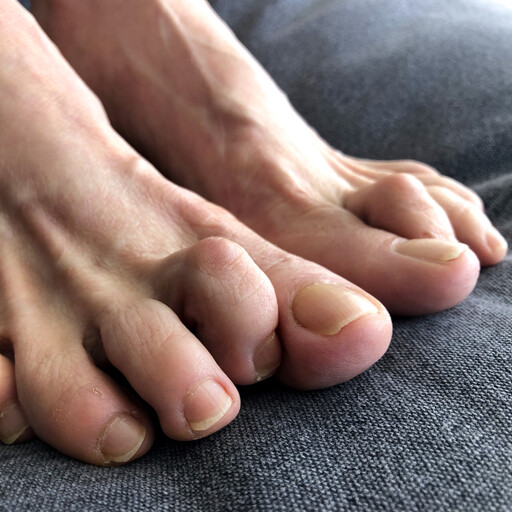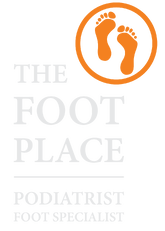Claw Toes
A Claw toe is a deformity that causes your toe to bend or curl downward instead of pointing forward. This “abnormal” position can almost be referred to as “normal” as so many people have them. We only become involved in their treatment when the toe position produces pain, infection or irritation within footwear. Women are more likely to get pain associated with hammertoes than men because of footwear.
Signs & Symptoms
A clinical sign of a Claw toe is when the base of your toe is bent upward (extension) from the joint at the ball of the foot and toes are at the middle joints are contracted causing your toe to curl, bending towards ground..
A Claw toe is a toe that is contracted at the Proximal Inter-Phalangeal Joint (PIPJ) and Distal Inter-Phalangeal Joint (DIPJ) (middle and end joints in the toe), and can lead to severe pressure and pain. Ligaments and tendons that have tightened cause the toe's joints to curl downwards.
Claw toes may occur in any toe, except the big toe. There is often discomfort at the top part of the toe that is rubbing against the shoe and at the end of the toe that is pressed against the bottom of the shoe. Painful corns may develop at the top and end of the toe or under the ball of the foot. Sometimes patients complaint of a deep stone bruise type pain in the balls of their feet, like walking on bone, or walking on a fluid sack or walking on glass. Patients can experience burning in their feet or numbness and cramps within their arch or calf muscles.
Causes
Claw toes result from a muscle imbalance which causes the ligaments and tendons to become unnaturally tight. This results in the joints curling downwards. A Claw toe deformity has a cocked-up MTP joint, and both the middle joint (the PIPJ) and the tiny joint at the end of the toe (the DIPJ) are curled downward like a claw.
Claw toes are common in people with high arches and they can come from a muscle imbalance within the foot and leg. It may be as a result of the calf muscles (flexors) being too tight and powerful, over powering the smaller muscles at the front of the leg (extensors) designed to help lift the foot up when walking. The extensors of the toes then have to over work to try and help lift the foot, to stop it from dragging on the ground - this is called extensor substitution. The over worked, prolonged contraction of the toe extensors hold the toes up that help to create the claw toe shape. This is called a deforming force, i.e. the contracting force that bends and holds the toe into a claw toe shape.
Claw toes are classified based on the mobility of the toe joints. There are two types - flexible and rigid.
In a flexible claw toe, the joint has the ability to move. This type of claw toe can be straightened manually.
A rigid claw toe does not have that same ability to move. Movement is very limited and can be extremely painful. This sometimes causes foot movement to become restricted leading to extra stress on the ball-of-the-foot, and possibly causing pain and the development of corns and calluses.
Claw toes can also be caused by:
Ankle fractures or surgery
Cerebral palsy
Charcot-Marie-Tooth disease
Other brain and nervous system disorders
Rheumatoid arthritis
Diagnosis
The correction of any foot disorder is dependent on the provider understanding the cause of that disorder.
Our specialist podiatrist, Stefan, is also a podiatric radiographer. Stefan is highly qualified and experienced with over 30 years of clinical practice. His knowledge and experience enables him to offer a thorough, in-depth assessment of your condition. This may include but is not limited to a biomechanical examination, gait analysis, colour doppler ultrasound, low dose digital X-ray, low dose fluoroscopy. In some cases haematological tests or a referral to MRI may be required. Once a diagnosis is determined; he will spend time to fully explain your condition, providing treatment options aimed at providing you with a long-term pain relief for your specific condition.
Treatment
The treatment of a Claw toe depends upon the severity of the condition. This can be related to the progression of the Claw toe; if it’s flexible, semi rigid (semi-reducible) or rigid (non-reducible).
A thorough in-depth examination is undertaken to help determine the cause of the claw toe.
It can be related to a muscular imbalance within the foot and leg. If this is the case the use of stretching and strengthening regimes may be recommended. Sometimes night splints may be recommended to help stretch powerful and tight calf muscles.
Claw toes can also be associated with a high foot arch. This foot type can cause a hard heel strike with high impact. The use of prescription orthotics and/or a change of footwear can help to reduce this excessive force.
Treatment may include recommendations of a regime of specific, targeted mobilisation / stretching techniques that you can do at home. Over time, these can help straighten the toe and reduce its rubbing within footwear.
Sometimes a custom made device can be made to help deflect pressure away for the toe providing pain relief within foot wear.
Prevention
Early treatment for a painful or irritating Claw toe is recommended. This helps to reduce other injury that is commonly associated with this condition to help you maintain a pain free, healthy and happy quality of life.
Claw toes can be caused by tight-fitting footwear. Tight-fitting hosiery, in-particular tight fitting “onesies” for infants can also harm the growing foot and cause toe deformities. It’s best to cut young feet free and let cover them in cosy, loose-fitting clothing. Other toe shapes are inherited and there is little we can do to influence their shape. In general, give your toes room to breathe, treat them like fingers rather than sausages and do your best to accommodate their shape rather than force them into spaces that are too tight.
Any exercise aimed at improving your general flexibility is also highly recommended. This includes but is not limited to:
Pilates
Yoga
Tai chi
Regular deep tissue/sports massage
Acupuncture
Regular osteopathic treatment
Regular chiropractic treatment
Regular physiotherapy

